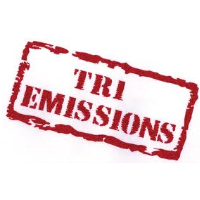Toxic Releases in California Increased 10% in 2011

Major industrial sectors in California released 10% more toxics into the air, water and land in 2011 than the year before, according to an annual report released by U.S. Environmental Protection Agency (EPA).
The EPA's Toxics Release Inventory (TRI), using data gathered from 1,265 state facilities, calculated that 38.3 million pounds of toxic chemicals were released on-site in 2011. Many of the releases from TRI facilities are regulated under various EPA programs. Data was gathered by mid-2012 and published at the beginning of this year.
Releases into the air actually decreased about 10% (1 million pounds) from the year before, but water releases were up 10% (258,000 pounds), on-site land rose 9% (2 million pounds), underground injection decreased 67% (2.5 million pounds) and off-site transfers were down 72% (2.5 million pounds).
The hazardous waste/solvent recovery industry accounted for 35% of the releases, followed by petroleum (16%), federal facilities (12%), metal mining (7%), primary metals (7%) and all other (23%).
Clean Harbors Buttonwillow LLC was the clear toxic releases leader, nearly tripling its nearest competitor with 9.9 million pounds of gunk. The commercial hazardous waste storage, treatment and disposal facility near Bakersfield in Kern County released about 2.5 times more toxics than the U.S. Marine Corps Chocolate Mountains Aerial Gunnery Range near Niland in Imperial County.
Copper and copper compounds are the most common toxic release, followed by nitrate compounds, lead and lead compounds, asbestos and ammonia.
The EPA established more stringent reporting requirements for persistent bioaccumulative toxic (PBT) chemicals in 2000 because of particular concern about their staying power in the environment. They are not easily destroyed and build up in body tissue. They include mercury, dioxin and polychlorinated biphenyls, but lead and lead compounds are overwhelmingly the largest source.
Releases of PBTs were up 24% since 2010. Mesquite Mine near Brawley in Imperial County tops the list of facilities releasing PBTs.
The Top 10 facilities in California for 2011 based on total releases (in pounds) of toxic materials were:
| Company | City | County | Total Releases |
| Clean Harbors Buttonwillow LLC | Buttonwillow | Kern | 9,861,640 |
| US Marine Corps - Chocolate Mountains Aeirial Gunnery Range | Niland | Imperial | 3,903,712 |
| Chemical Waste Management Inc. | Kettleman City | Kings | 3,901,513 |
| Mesquite Mine | Brawley | Imperial | 2,583,483 |
| Chevron Products Co. Div. of Chevron USA Inc. | El Segundo | Los Angeles | 1,772,493 |
| Quemetco Inc. | City of Industry | Los Angeles | 1,576,634 |
| SGL Technic Inc. Polycarbon Div. | Santa Clarita | Los Angeles | 1,332,051 |
| ConocoPhillips - San Francisco Refinery | Rodeo | Contra Costa | 896,733 |
| BP West Coast Products LLC - Carson BP Carson Refinery | Carson | Los Angeles | 579,055 |
| Valero Refining Co. - California Benicial Refinery | Benicia | Solano | 504,472 |
The Top 10 chemicals released (in pounds) in the state in 2011 were:
| Chemical | Total Releases |
| Copper & Copper Compounds | 5,630,344 |
| Nitrate Compounds | 5,073,831 |
| Lead and Lead Compounds | 4,887,617 |
| Asbestos (Friable) | 3,209,127 |
| Ammonia | 2,813,077 |
| Methyl Tert-Butyl Ether | 1,884,235 |
| Styrene | 1,219,474 |
| Zinc & Zinc Compounds | 1,198,390 |
| N-Hexane | 1,165,769 |
| Toluene | 1,124,466 |
–Ken Broder
To Learn More:
Toxics Release Inventory 2011 California Report (U.S. Environmental Protection Agency)
EPA’s 2011 Toxics Release Inventory Shows Air Pollutants Continue to Decline (U.S. Environmental Protection Agency)
- Top Stories
- Controversies
- Where is the Money Going?
- California and the Nation
- Appointments and Resignations
- Unusual News
- Latest News
- California Forbids U.S. Immigration Agents from Pretending to be Police
- California Lawmakers Urged to Strip “Self-Dealing” Tax Board of Its Duties
- Big Oil’s Grip on California
- Santa Cruz Police See Homeland Security Betrayal in Use of Gang Roundup as Cover for Immigration Raid
- Oil Companies Face Deadline to Stop Polluting California Groundwater





